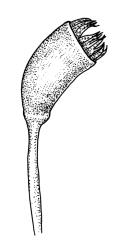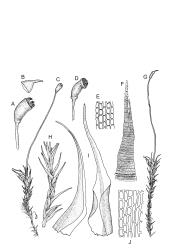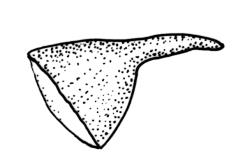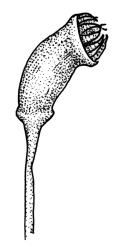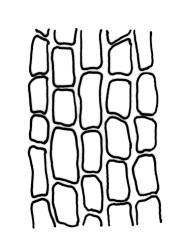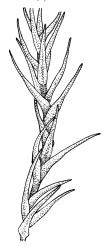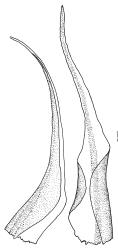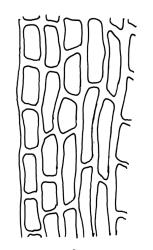- ≡ Dicranum schreberianum Hedw., Sp. Musc. Frond. 144 (1801)
- = Aongstroemia subredunca Müll.Hal., Hedwigia 37: 114 (1898)
- = Dicranum waimakaririense R.Br.bis, Trans. & Proc. New Zealand Inst. 35: 330 (1903)
Plants small and delicate, yellow-green, forming turves. Stems 5–15 mm, in cross-section with a distinct central strand and 2–3 layers of firm-walled cortical cells. Leaves on sterile stems and lower portion of fertile stems wide-spreading or loosely secund, weakly contorted when dry, lanceolate or ovate-lanceolate, neither shouldered nor sheathing (lacking a differentiated base), acuminate, entire or with a few small teeth at extreme apex, mostly 0.8–1.5 × c. 0.3–0.6 mm, ± concave throughout, plane at margins; leaves of fertile stems becoming larger (to c. 2.0 mm immediately below the perichaetium), shouldered and distinctly sheathing the upper stems; upper laminal cells short-rectangular, c. 15–21 × 5–8 µm and 3–4:1, firm-walled, unistratose, smooth, becoming somewhat larger (c. 30 × 12 µm) near leaf base. Costa occupying c. ⅕ of the leaf base, well defined, percurrent, not filling the subula, in cross-section with median guide cells and abaxial and adaxial stereid groups all weakly differentiated, with the cells on the adaxial surface more elongate than adjacent laminal cells. Tubers rare, globose, brown, c. 110–135 µm diam.
Dioicous. Perichaetia usually more than one per stem, with leaves considerably longer (2–3 mm), and more distinctly shouldered and sheathing than vegetative leaves. Perigonia terminal, gemmiform. Setae c. 7–10(–14) mm, rather slender, weakly sinistrorse, red-brown; capsules inclined or suberect when fresh or moist, becoming more strongly inclined when dry, weakly to distinctly asymmetric, short-obovoid and constricted below the mouth when dry, c. 0.8–1.5 mm, weakly strumose, minutely furrowed when dry (due to columnar arrangement of exothecial cells); mouth slightly oblique to ± transverse; exothecial cells rectangular, quadrate or ± irregular, with the longitudinal much thicker than the transverse walls and the cells arranged in ± distinct columns; stomata absent; annulus absent; operculum rostrate and curved, slightly shorter than the urn. Peristome teeth variable in length (240–)300–380 × c. 60 µm, unequally divided c. ½ to base, adjacent teeth occasionally anastomosing below, not perforate below the forks, the outer surface of the lower tooth bearing fine trabeculae traversing the full width of the tooth, the inner surface with a zig-zag line that divides the tooth vertically into asymmetric segments, the entire tooth in surface view appearing papillose-striolate. Calyptra as per genus. Spores (15–)18–21(–25) µm, smooth or nearly so.
The entire (save a few small teeth at apex) leaf margins, the narrower and percurrent costae, and red-brown setae distinguish D. schreberiana from D. heteromalla.
When sterile, D. schreberiana could be confused with members of the Ditrichaceae, particularly with the poorly documented Trichodon cylindricus, which has more strongly toothed leaf margins and costae that fill the upper subulae. Trichodon is not known to fruit in N.Z. and usually produces pyriform tubers. Dicranella schreberiana could also be confused with Wilsoniella blindioides, but the latter species has a less distinct central strand, no mid costal guide cells, much longer laminal cells, and lacks sheathing vegetative leaf bases.
NI: N Auckland (Waiwera, Russell to Whangārei Road, Tāheketītī, near Wellsford), S Auckland, Gisborne (Mt Hikurangi, Waikaremoana), Hawke’s Bay (numerous localities, mostly near Wairoa), Taranaki (Mt Messenger), Wellington (Ōhakune, near Raetihi, Mauriceville and vicinity); SI: Nelson (Parapara, Kōhaihai Bluff), Marlborough (Mt Fyffe), Canterbury (Black Range, Bealey River, Cave Stream, Porter River, Selwyn River, Christchurch), Westland (Greymouth), Otago (many localities).
Apparently bipolar. According to Smith (2004) this species is "circumpolar boreo-temperate" in distribution. He considers it common in lowland areas of Britain and to occur also in "Europe north to Fennoscandia, Iceland, Caucasus, Siberia, Korea, Azores, N. America, Australasia".
No other southern hemisphere localities can be confirmed here. Scott & Stone (1976), quoting Index Muscorum, recorded this species from Tasmania. Reports of so-called Dicranella jamesonii from Tasmania (e.g., Dalton et al. 1991, based on an earlier but tentative report by Sainsbury 1955) and mainland Australia (Streimann & Klazenga 2002) are perhaps based on D. schreberiana. Likewise, Streimann & Klazenga (2002) recorded D. jamesonii from N.S.W., S.A., and Vic.; Other mainland Australia records of putative D. jamesonii were cited by Scott & Stone (1976) and by Catcheside (1980).
This is an inconspicuous and "weedy" species, which often grows on moist clay or silt banks, shaded by riparian willows. It ranges from near sea level (Wairoa) to at least 600 m (Ōhakune) on the North I. and to c. 800 m (Porter River) on the South I. Ceratodon purpureus and Pohlia tenuifolia are occasional associates.
The non-sheathing vegetative leaves that gradually merge into the larger, more sheathing and distinctly shouldered perichaetial leaves facilitate recognition. All the leaves have a distinct lamina throughout, smooth cells and entire (except for sometimes a few small apical teeth) margins. There is considerable variability in capsule length, with short-capsuled forms (in some populations all capsules are c. 0.8 mm) having the struma weakly developed and capsules less distinctly inclined than populations with longer capsules. The capsules are weakly to distinctly asymmetric, and inclined or suberect when fresh, but more strongly inclined upon drying. Dixon (1914, p. 67, as D. jamesonii) opined that the immature capsules form a "substrumose ring" on drying. There is also marked variation in the length of the peristome teeth.
The earliest mention of this species in N.Z. literature was made by Wilson (1854, p. 65, as Dicranum schreberi Hedw.) in reference to a J.D. Hooker collection from the Bay of Islands. Wilson noted that the Hooker collection had completely entire leaves and thus approached the European Dicranella grevilleanum (Brid.) Schimp. [Coroll. Bryol. Eur., 1856]. The name Dicranum schreberi Hedw. was also used in Hooker’s (1867) Handbook. Crum & Anderson (1981, p. 169) have clarified some of the early nomenclature of this taxon, and their synonymy is not repeated here.
The first published suggestion that N.Z. material might be referred to the South American Dicranella jamesonii was made by Beckett (1894) who, quoting Mitten, cited T. Kirk 299 (CHR 532392) from Lake Whangapē (S Auckland L.D., cited as Whangapehatu) as Anisothecium jamesonii. The Kirk collection has a few minute apical teeth and is referred here to D. schreberiana.
Almost certainly at Mitten’s urging, Beckett cited several South American syntypes of "Anisothecium jamesonii" and "Angstroemia hookeri" to illustrate his synonymy and his species concept. However, the Kirk collection is assuredly not the same species as syntypes of Anisothecium jamesonii Mitt. The status of the South American Dicranella/Anisothecium jamesonii and taxa confused with it are briefly discussed here under D. cardotii; the resolution of the taxonomic and nomenclatural morass surrounding D. jamesonii is beyond the scope of this work. The common and widespread N.Z. species first collected by J.D. Hooker in the Bay of Islands is most appropriately named D. schreberiana.
Dixon (1914, p. 66) indicated that the N.Z. Aongstroemia redunca Müll.Hal. [Hedwigia 37: 115, 1898] belongs in the synonymy of the misunderstood D. jamesonii, but no type material of this name has been identified or seen. Müller’s protologue gives no indication of a type for A. redunca.
Rhizoidal tubers have been seen only in a collection from Canterbury L.D. (P.J. Garnock-Jones 245 from Selwyn River headwaters, CHR 267609) and in a scant collection from Ātiamuri, S Auckland L.D. (K.W. Allison 114, CHR 532345B). Both these collections have shorter than usual capsules.



